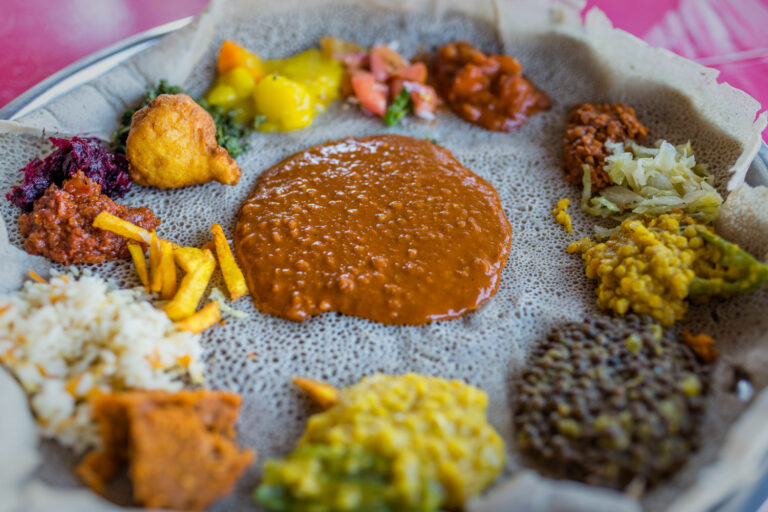Introduction: Ethiopian cuisine and injera
Ethiopian cuisine is renowned for its unique flavors, rich textures, and vibrant colors. It is a fascinating blend of influences from Africa, the Middle East, and Europe, which has evolved over centuries of trade and cultural interactions. One of the most iconic and beloved foods in Ethiopian cuisine is injera, a sourdough flatbread that is central to the country’s culinary tradition.
What is injera and how is it made?
Injera is a staple food in Ethiopia, Eritrea, and Somalia, where it is served with almost every meal. It is a large, spongy, and slightly tangy flatbread that is typically made from teff flour, a gluten-free grain that is native to Ethiopia. The dough is mixed with water and left to ferment for several days, during which it acquires a sour taste and a bubbly texture. The fermented batter is then poured onto a hot clay griddle called a mitad, where it cooks for a minute or two on one side only. The result is a soft, crepe-like bread that is perfect for scooping up stews, sauces, and vegetables.
Why is injera important in Ethiopian cuisine?
Injera is much more than just a bread in Ethiopian cuisine. It is the foundation of the communal dining experience known as gursha, where people share food from a common platter using injera as a utensil. It is also a symbol of hospitality, as guests are always offered injera and a variety of dishes to accompany it. Injera serves as a versatile and nutritious source of carbohydrates, protein, and vitamins, making it an essential element of the Ethiopian diet. The bread’s distinctive sourness helps to stimulate digestion and balance the acidity of spicy and fatty dishes.
Historical and cultural significance of injera
Injera has a long and fascinating history that reflects the diversity and complexity of Ethiopian culture. It is believed to have originated in the highlands of Ethiopia around 2,000 years ago, where teff was first cultivated. Over time, injera became an integral part of religious and secular ceremonies, such as weddings, funerals, and religious festivals. The bread’s circular shape and the way it is shared symbolize unity, equality, and social harmony. Injera is also associated with social status, as the ability to serve and eat it with grace and skill is considered a mark of refinement and sophistication.
Nutritional benefits of injera
Injera is a highly nutritious food that provides a balance of carbohydrates, protein, and fiber. It is rich in essential vitamins and minerals, including iron, calcium, and magnesium. The fermentation process increases the bioavailability of nutrients and enhances the bread’s nutritional quality. Injera is also gluten-free, low in fat, and has a low glycemic index, which makes it suitable for people with celiac disease, diabetes, and other health conditions.
Variations and regional differences in injera
Injera is a versatile bread that can be adapted to different tastes and preferences. There are several varieties of teff flour, each with a unique flavor and texture. Some people prefer to mix teff with other grains, such as wheat, barley, or corn, to create hybrid injera. Regional differences also influence the way injera is made and served. For example, in the northern parts of Ethiopia, injera is typically thinner and lighter, while in the south, it is thicker and fluffier.
Serving and eating injera
Injera is best enjoyed when it is freshly made and warm. It is usually served on a large platter, with a variety of stews, salads, and dips arranged around it. To eat injera, tear off a small piece of the bread with your fingers and use it to scoop up a portion of the food. The bread’s spongy texture and sour taste help to absorb and balance the flavors of the other dishes. Injera is also often used as a wrap or a base for pizza-style toppings.
Conclusion: The enduring appeal of injera in Ethiopian cuisine
Injera is a beloved and iconic food that represents the heart and soul of Ethiopian cuisine. Its unique taste, texture, and cultural significance have made it a staple food that is enjoyed by millions of people around the world. Injera’s enduring appeal lies in its versatility, adaptability, and nutritional value, which make it a perfect accompaniment to a wide range of dishes. As Ethiopians say, “Enjera ye Ethiopia, yemiyaslenal” – “Injera is to Ethiopia what rice is to China.”

